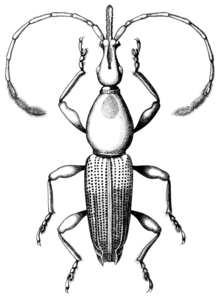| Brentidae | |
|---|---|

| |
| A brentid from the Western Ghats | |
| Scientific classification | |
| Domain: | Eukaryota |
| Kingdom: | Animalia |
| Phylum: | Arthropoda |
| Class: | Insecta |
| Order: | Coleoptera |
| Infraorder: | Cucujiformia |
| Clade: | Phytophaga |
| Superfamily: | Curculionoidea |
| Family: | Brentidae Billberg, 1820 |
| Subfamilies | |
| |

Brentidae, sometimes known as the primitive weevils, is a cosmopolitan family of primarily xylophagous beetles also known as straight-snouted weevils. The concept of this family has been expanded with the inclusion of three groups formerly placed in the Curculionidae; the subfamilies Apioninae, Cyladinae, and Nanophyinae, as well as the Ithycerinae, previously considered a separate family. They are most diverse in the tropics, but occur throughout the temperate regions of the world. They are among the families of weevils that have non-elbowed antennae, and tend to be elongate and flattened, though there are numerous exceptions.
YouTube Encyclopedic
-
1/1Views:5 183
-
The Most Beautful Weevil Beetle In The World
Transcription
Classification
The subfamilial classification of the family has been reorganized by several different authors within the last 20 years, and is not yet stable; the most recent, and conservative, classification (Oberprieler et al., 2007) accepts only 6 subfamilies, with many familiar subfamilial taxa (e.g., Antliarhininae, Cyladinae, Cyphagoginae, Myrmacicelinae and Trachelizinae) now relegated to the corresponding tribal groups, Antliarhinini, Cyladini, Cyphagogini, Myrmacicelini and Trachelizini, primarily within the subfamily Brentinae.
The New York weevil has been included in a broadly defined family definition, placed as the only genus in a subfamily Ithycerinae,[1] This position has not been retained by some authors who treat the genus and its extinct relatives treated as the separate family Ithyceridae.[2]
There are 4000 known species of Brentids.[3]
Description
Brentid larvae are fungivorous, eating fungi on dead wood. The adults are usually long and dark, and can be as small as 1.5 mm or as long as 90.[3]
See also
References
- ^ Shin, S.; Clarke, D. J.; Lemmon, A. R.; Moriarty Lemmon, E.; Aitken, A. L.; Haddad, S.; Farrell, B.; Marvaldi, A. E.; Oberprieler, R. W.; McKenna, D. D. (2018). "Phylogenomic data yield new and robust insights into the phylogeny and evolution of weevils". Molecular Biology and Evolution. 35 (4): 823–836. doi:10.1093/molbev/msx324. hdl:11336/57287.
- ^ Legalov, A. A. (2020). "Fossil history of Curculionoidea (Coleoptera) from the Paleogene". Geosciences. 10 (9): 358. Bibcode:2020Geosc..10..358L. doi:10.3390/geosciences10090358.
- ^ a b Barclay, Maxwell; Bouchard, Patrice (2023). Beetles of the World: A Natural History. Canada: Princeton University Press. pp. 220–221. ISBN 978-0-691-24073-2.
- Oberprieler, R. G.; Marvaldi, A. E.; Anderson, R. S. 2007: Weevils, weevils, weevils everywhere. pp. 491–520 in: Zhang, Z.-Q. & Shear, W. A. (Eds) Linnaeus tercentenary: progress in invertebrate taxonomy. Zootaxa, 1668: 1–766. [1]
External links
- Images of Brentidae species found in New Zealand
- Brentinae - primitive Weevils of Florida on the University of Florida / Institute of Food and Agricultural Sciences Featured Creatures website
 Data related to Brentidae at Wikispecies
Data related to Brentidae at Wikispecies
